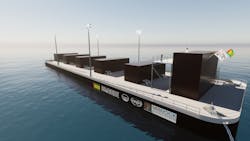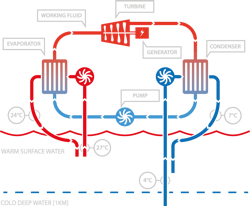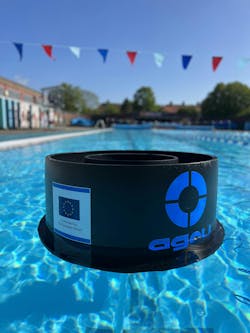Ocean energy development offers lower-cost power source for tropical islands
Editor's note: This feature article first appeared in the November-December 2023 issue of Offshore magazine. Click here to view the full issue.
By Jeremy Beckman, Editor-Europe
FIRST OFFSHORE TRIALS of a small-scale Ocean Thermal Energy Conversion (OTEC) process should start in the mid-2020s, with a barge-based system in the waters off São Tome and Principe in West Africa.
London-based developer Global OTEC presented an update on the project, named Dominique, at the International Vienna Energy and Climate Forum last month, including recent improvements to the system’s functionality. The next planned milestone will be a geotechnical survey of the seabed at the proposed offshore location with results used to finalize detailed design of the pilot 1.5-MW system. Fabrication can then begin of the barge and process equipment followed by installation of the completed system and offshore commissioning, currently targeted for late 2025.
OTEC is a technology that works best in tropical regions. The process makes use of both warm water at the sea surface and cold water deeper down to drive turbomachinery configured for continuous power production. Typically, it employs a closed or open cycle power generation or a hybrid of the two. Theoretically, the technology can provide a constant baseload power source year-round. Various pilot projects have undergone development since the 1970s with successful tests conducted at varying distances offshore, mainly in the Pacific region. But although some demonstrator facilities are still in operation, none have so far presented a convincing case to warrant investment in a full-scale commercial development generating 50 MW or more.
But worldwide pressures to expand adoption of renewable energy sources are making the market more receptive to the process. Global OTEC’s focus is on commercializing OTEC technology in a suitable format to supply affordable and reliable power to small tropical island states struggling to cope with high energy costs.
The company, formed in 2017, produced its initial basis-of-design following a letter of support from the Cayman Islands and a letter of intent for a project in the Maldives. Over the next two years, it secured grants from Marine-i (part-funded by the European Regional Development Fund): these allowed it to open an R&D center in Cornwall, south-west England to develop the initial concepts, designs, technical and feasibility studies for the use of OTEC as a power source.
In 2020, after the proposed demonstration in the Maldives fell through due to the pandemic, management decided to target developments involving public/private partnerships. In practice, explains Global OTEC founder and CEO Dan Grech, “host nations are not required to make financial contributions towards the projects. However, they are able to access new, innovative climate finance mechanisms through accredited entities such as the United Nations Industrial Development Organization to build capacity and enhance the project with concessions.” In 2021, the company signed a Memorandum of Understanding (MoU) on a collaboration with SIDS DOCK, an inter-governmental organization representing 32 small island developing states, the initial focus being the pilot project in São Tome and Principe.
And after entering another MoU with the government of São Tome and Principe for a power purchase agreement, Global OTEC received more funding from the EU’s Horizon Europe and UK Research and Innovation (UKRI) for the PLOTEC consortium, the proposal for which the company leads, the other members being Agru, Cleantech Engineering, University of Plymouth, PLOCAN, WavEc and Quality Culture. This is a separate development, the goal being to develop a cylindrically-hulled OTEC structure and cold water riser pipe that can withstand more severe weather conditions, validated by a scaled demonstration of the structure. The demo is due to be staged next year at the PLOCAN test site in the Canary Islands: the consortium has been finalizing designs of the individual components and liaising with local shipyards on the construction process.
Global OTEC is responsible for all aspects of the functionality and design of the OTEC system. Earlier this year the company ran computer simulations and conducted a physical scaled test in a tank in Charlton Lido in London of a prototype cylindrical hulled OTEC and cold water riser pipe: both passed the initial simulations, functioning as intended. The larger scaled structure that will be built for the Canary Islands trials will be subjected to more turbulent conditions in the Atlantic Ocean over a 12-month period.
LR, ABL approvals
Overall this year the company has made good progress, Grech says. “Lloyd’s Register awarded Approval in Principle (AiP) for our 1.5-MW floating OTEC Dominique system. The AiP process provides technology developers with early confidence that their technology is capable of being appraised against existing codes and standards: in this case, the award acknowledges that the barge can fulfil the necessary requirements for providing a structural basis for the OTEC technology.
“We also got a Certificate of Approval from marine warranty surveyor company ABL Group for the methodology of installation of a cold-water riser for use with our offshore OTEC platform. This was a crucial step in the design process, as it involved the use of standards already tested and applied to the offshore oil and gas industry for implementation in OTEC deployments. ABL Group’s approval was particularly important given the technical challenges that confronted earlier OTEC installations and the long history of unsuccessful implementations.”
This year management also presented its technology to governments and other interested parties from island nations including Fiji, Turks and Caicos and Grenada. “Other countries that have shown interest in being the next in line to receive OTEC are Belize, Grenada, and Tonga. To manage this demand, we have partnered with SIDS DOCK…and they are calling for OTEC to be recognized as a priority technology. As for Dominique we have made further progress with completion of an advanced design of the platform and engagement with potential local and international partners for the development.” As a start-up company, Global OTEC currently has a 10-strong team, along with advisors and investors, and discussions have taken place with technical partners on expanding the team once construction starts for the Dominique project.
“Our specialization is closed cycle OTEC thermal energy conversion. The closed cycle operates between pressures of 10 bar and 6 bar, [1 bar equal to 1 atmospheric pressure], corresponding to the chosen working fluid, in this case ammonia, at temperatures of 24°C and 11°C respectively [75°/52°F]. In this cycle, the ammonia is pumped into a heat exchanger warmed by the surface seawater. The warm water intakes draw in seawater from the surface of the ocean via multiple pumps, with a filtering system to avoid fouling the heat exchangers, which are made from a corrosion-resistant material. The expanded vapor is then condensed back to a liquid using the cold deep seawater, drawn up via a riser pipe, in another heat exchanger before being pumped back to the evaporator to continue the cycle. The process is designed to operate 24 hours a day, all year round, producing clean electricity to tropical islands.
“For the riser pipe development, one of the process’ most critical components, we are partnering with an industry leader in riser Inlet technology. The cold water riser is a 750-m HDPE pipe which is again resistant to seawater corrosion. Work on the connection point is being performed within the PLOTEC demonstrator hull as it provides an excellent opportunity to perform more physical testing of the processes involved in riser installation. The riser connection point has been designed with life-cycle impact on the riser, and ease of installation, in mind. Many countries that would like to access their OTEC potential don’t necessarily have easy access to large installation vessels.”
To maximize efficiency of the closed cycle system for Dominique, 500-kW turbines will be used on the barge, which has been designed and analyzed to relevant Classification Society standards to be capable of withstanding 100-year storm conditions off São Tome and Principe. “But conditions in this region are relatively benign compared with other parts of West Africa,” Grech stresses, “and that in turn allows for a more efficient and cost-effective structure. In fact, São Tome and Principe has the best conditions in the world for OTEC implementation. Its warm surface sweater is available during the whole year, and cold deep water is reached at a depth of 750 m. All necessary sea states have been considered for the platform.”
The floating platform for Dominique will be a class 300 barge with dimensions of around 90 x 28 x 54.5 m, with the necessary alterations to operate an array of modular OTEC power plants, and a steel hull to maximize the amount of space available on the vessel for equipment and pipework. “While a concrete barge may be cheaper to manufacture, the lack of under deck space means that all equipment would be exposed to the elements. The steel hull also allows for under deck refrigerant storage, and a smaller form factor as pipework can be routed under the deck while allowing for easy access.
“The current design has two decks planned, however if necessary, a gantry/mezzanine can be included for equipment that is less sensitive to accelerations. The barge will be moored using a non-redundant, four-point spread moored configuration roughly 10 km offshore São Tome, but this is highly location specific. For other OTEC projects in different regions, each location will have a different depth at which the necessary cold water temperatures are reached, and bathymetry also varies from country to country. For Dominique a disconnectable riser isn’t necessary as the sea states are sufficiently calm. For other locations, the disconnection procedure would be proprietary, and should also be enabled with minimal vessel assistance.”
Dominique's barge will operate fully uncrewed although during installation and commissioning, there will be periods where personnel attendance will be needed for specific activities. “The vessel is sufficiently close to shore that this can be done via small vessels shuttling crew with a designated vessel landing planned, though the possibility of a hotel barge alongside has been considered. There are various methods of shore communication, with both wired and wireless options under consideration for the final design. Monitoring of the barge's condition will be performed via a proprietary software, though there will always be a manual interface on the barhe to assist with operations and maintenance.”
SIDS DOCK is the facilitator of the public-private-partnership for the Dominique project with the Government of São Tome and Principe, supported by UNIDO.
This year Global OTEC signed another MoU with French company ENOGIA to develop key subsystems for the first commercial-scale OTEC floating platforms. ENOGIA is a specialist developer of Organic Rankine Cycle (ORC) turbines. The partnership will build some of the critical components for Dominique, and should help to make OTEC a more viable and cost-effective option for renewable power generation worldwide, Grech says. “The technology is suitable for all of the tropical areas of the ocean where water depths can reach at least 1,000 m. This comprises over 100 territories that can be powered by the ocean.”
About the Author
Jeremy Beckman
Editor, Europe
Jeremy Beckman has been Editor Europe, Offshore since 1992. Prior to joining Offshore he was a freelance journalist for eight years, working for a variety of electronics, computing and scientific journals in the UK. He regularly writes news columns on trends and events both in the NW Europe offshore region and globally. He also writes features on developments and technology in exploration and production.



